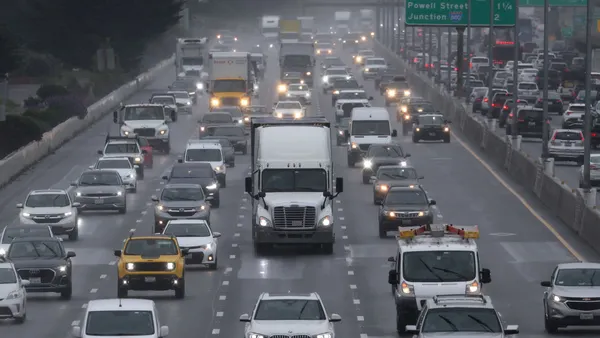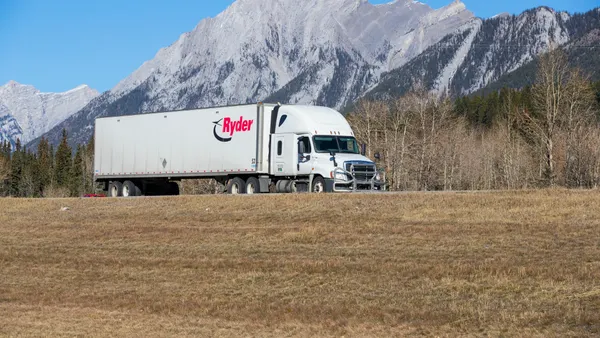Dive Brief:
- Particle pollution resulting from tire wear can be "1,000 times worse than exhaust emissions," Emissions Analytics said in a recent press release. The U.K.-based firm carried out initial tire-wear testing using a hatchback vehicle, noting several factors — including road conditions, quality of tire, tire inflation and vehicle weight — could exacerbate pollution levels. The hatchback, with correctly inflated tires, emitted 5.8 grams per kilometer of particles. U.K. regulations limit exhaust emissions to 4.5 milligrams per kilometer.
- The Emissions Analytics findings have at least one critic. Mike Hawes, chief executive of the Society of Motor Manufacturers and Traders, the U.K. motor trade association, said, "Making sensationalist claims based on testing of a single vehicle is not credible and, quite frankly, irresponsible," according to Smart Transport.
- “The challenge to the industry and regulators is an almost complete black hole of consumer information, undone by frankly out of date regulations still preoccupied with exhaust emissions,” said Nick Molden, founder and CEO of Emissions Analytics, in the press release.
Dive Insight:
Tire emissions are not regulated in the U.K., nor are they regulated in the U.S. However, the U.S. is doing tests to gather data on non-exhaust emissions, which includes brake wear, tire wear, road wear, clutch wear and road dust resuspension.
"[The Environmental Protection Agency (EPA)] is currently working to understand emissions from non-exhaust sources in the transportation sector. We are currently conducting a study with the California Air Resources Board [(CARB)] on brake wear emissions of particulate matter," an EPA spokesperson told Transport Dive in an email Tuesday. Testing — results of which will inform emissions inventories, the spokesperson said — includes different brake configurations and materials, vehicle loads and driving behaviors, which will help shed light on how speed and braking behavior affect brake emissions.
California's Emissions Factor Model (EMFAC) already provides an estimate of brake-wear particulate matter (PM), but it's based on outdated information and does not consider newer technologies, such as regenerative braking, the study summary reads. "At the same time tailpipe emissions have decreased significantly such that brake and tire-wear PM emissions are now almost half of all vehicular PM emissions," according to the summary.
Non-exhaust emissions are difficult to measure and control, according to CARB. Couple that with harder to meet standards for exhaust emissions and the non-exhaust fraction is more vital.
The EPA's Motor Vehicle Emission Simulator (MOVES) and CARB suggest traffic-related emissions of certain-sized particles "will eventually be dominated by non-exhaust sources," the California government said, citing a 2016 study. But because of the a lack of up-to-date information on non-exhaust emissions, much like EMFAC, MOVES and CARB data does not account for new technology.
The industry, on the other hand, has been ramping up efforts to curb emissions from vehicle exhaust. The North American Council for Freight Efficiency (NACFE) said regional trucking operations should be early adopters of electric trucks.
Mike Roeth, NACFE executive director, told Transport Dive that there are a "fair amount" of electric trucks deployed now, but mainly for short hauls, such as trips from ports to warehouses. The concern in the trucking industry is Class 8 trucks tend to have a daily range of 200 miles maximum, Roeth said.
In California, the port commissions of Los Angeles and Long Beach recently approved a $10 fee — $20 for Class 8 trucks — to help finance a transition to electric vehicles at the two ports. The fee would be placed on trucks that don't meet state standards for low-or-zero emissions. Daimler Trucks North America (DTNA) recently added to its 30-vehicle Freightliner Electric Innovation Fleet, when it launched its Freightliner Customer Experience fleet to at least 15 customers, soliciting feedback.
"The road to emissions-free transportation is going to be driven with battery-electric vehicles," DTNA Roger Nielsen said last April. "I believe the future is electric."
According to Emissions Analytics, that won't be enough.
“Ultimately, though, the car industry may have to find ways to reduce vehicle weight too. What is without doubt on the horizon is much-needed regulation to combat this problem. Whether that leads to specific types of low emission, harder wearing [tires] is not for us to say — but change has to come," Molden said.
This brief was updated to include information from the Environmental Protection Agency, emailed to Transport Dive after press time.










